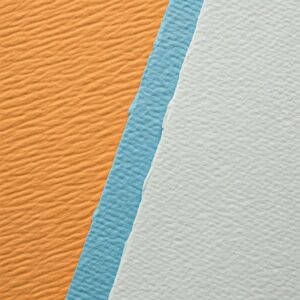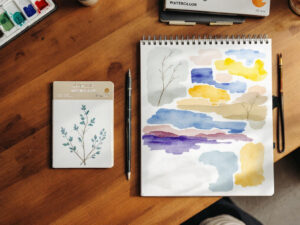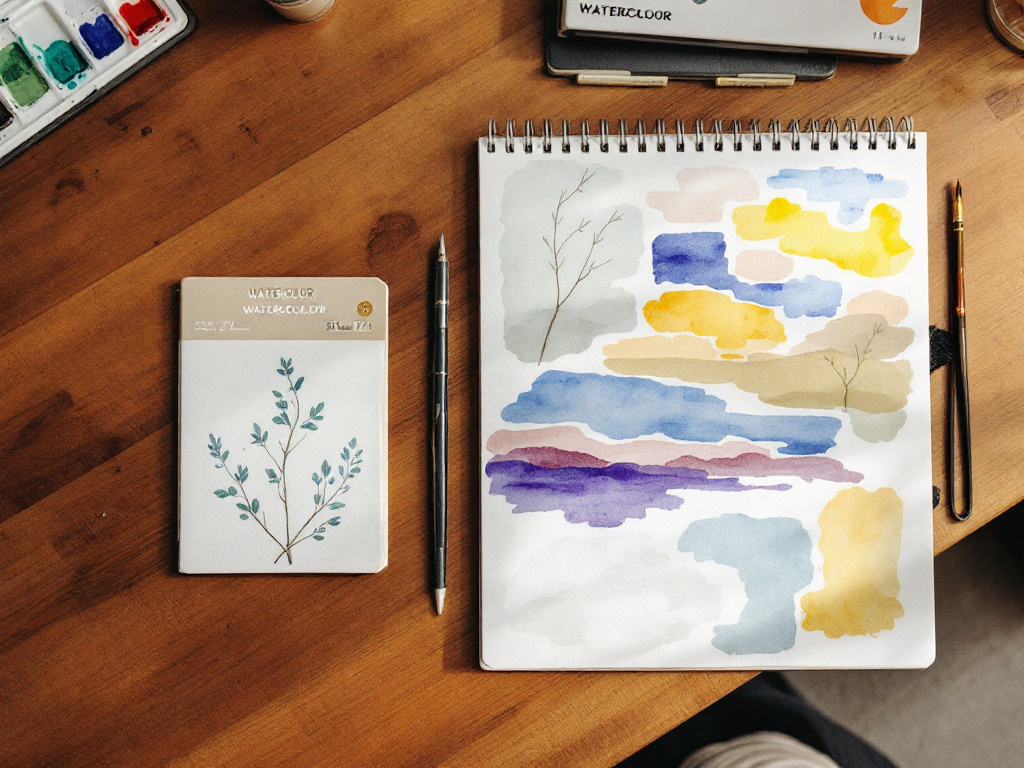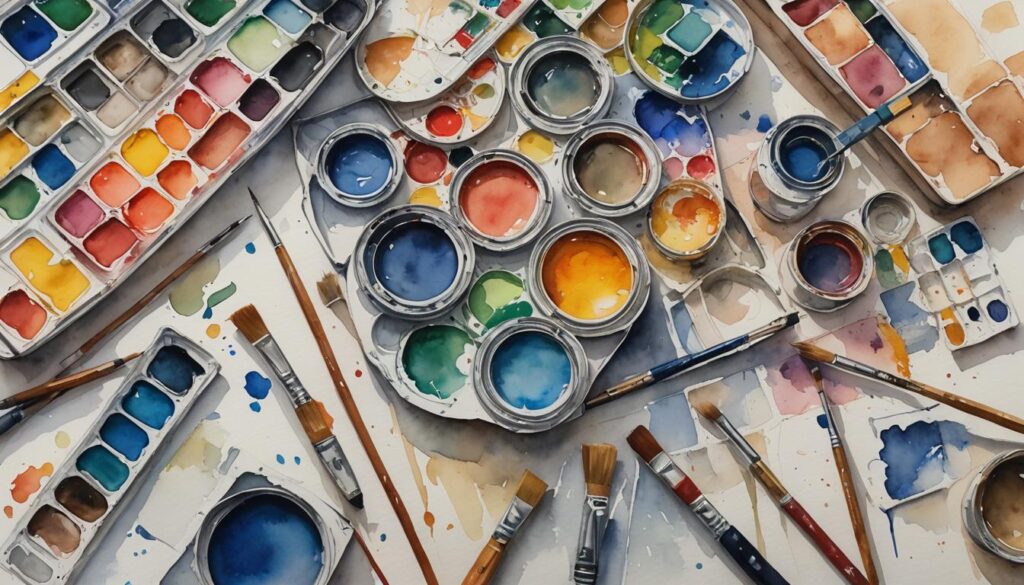Picking the right watercolor paper pads can make your paintings look amazing – whether you’re just starting out or ready to create something incredible. We’ll cover what makes watercolor paper special, the different types, how heavy it should be, what size to choose, and some great brands to try. With the right pad, your art will stand out, and you’ll feel awesome painting from our range of art supplies!
Key Points Summary:
- Watercolor paper pads come in three types: hot pressed (smooth), cold pressed (textured), and rough (bumpy).
- Weight varies—90 lb for sketches, 140 lb for most projects, and 300 lb for big, wet paintings.
- Sizes range from small (9×12 inches) to large (A3), depending on your project.
- Top brands like Arches and Canson offer quality options for all skill levels.
- Fun fact: weight is pounds (lb) in the US but grams per square meter (gsm) elsewhere, like 140 lb ≈ 300 gsm.
What Makes Watercolor Paper Special?
Watercolor paper isn’t like regular paper you’d use for school. It’s made strong for water-based paints, with a coating called sizing that keeps the paint from soaking in too fast. Picture spilling water on a napkin—it’d fall apart, right? This paper holds up. It’s usually made from cotton or a mix of cotton and wood pulp. If you want your artwork to stay bright and not fade—like something you’d pass down to your family—choose 100% cotton, acid-free paper. That’s the secret to long-lasting art!

Different Types of Watercolor Paper
There are three main types of watercolor paper, and each one changes how your painting looks. Hot pressed paper is super smooth, like a slick tabletop, perfect for tiny details—like painting a bird’s feathers up close. Cold pressed paper has a bit of texture, not too rough, and it’s great for almost any style, which is why so many artists pick it. Rough paper is bumpy and wild, ideal for big, splashy paintings like a stormy sea. The type you choose depends on what you’re creating!
How Heavy Should It Be?
Weight is super important when picking a watercolor paper pad. It tells you how thick and tough the paper is, measured in pounds (lb) in the US or grams per square meter (gsm) in other places. Light paper, like 90 lb (190 gsm), is perfect for quick sketches or practice—it’s easy and cheap. Most people use 140 lb (300 gsm)—it’s sturdy enough for lots of projects without costing too much. For giant paintings with tons of water, go for 300 lb (638 gsm)—it’s like the heavyweight champ of paper! Fun fact: 140 lb is about 300 gsm, which can confuse you if you’re shopping from different countries.
Check this out:
| Weight (lb) | Weight (gsm) | Best For |
|---|---|---|
| 90 lb | 190 gsm | Sketches, practice |
| 140 lb | 300 gsm | Most painting projects |
| 300 lb | 638 gsm | Big, wet masterpieces |
What Size Works Best?

Size is another big deal with watercolor paper pads. Smaller ones, like 9 by 12 inches or A4 (8.3×11.7 inches), are awesome if you’re painting somewhere fun—like outside or at a friend’s house. Bigger pads, like 11 by 15 inches or A3 (11.7×16.5 inches), give you more space for detailed or huge pieces. Think about what you’re making: small for a fast sketch, big for something you’d hang on the wall. It’s all about picking what fits your art!
Why Acid-Free Matters
Have you seen old papers turn yellow and crumbly? That’s acid at work. Acid-free watercolor paper, especially 100% cotton, stops that. It’s like locking your art in a safe—keeping it fresh for years. If you care about your paintings lasting, this is the way to go. The best brands make sure their paper is acid-free, so you’re covered.
Great Brands to Check Out
There are some fantastic brands for watercolor paper pads out there. Arches is a superstar—100% cotton and a favorite for pros because it’s so good. Saunders Waterford is another top pick, with smooth, reliable sheets. Canson makes pads that are perfect for beginners and won’t empty your wallet. Strathmore works for everyone, from new artists to pros, and Hahnemuhle, a fancy German brand, offers awesome acid-free options. Here’s what one artist thinks:
“Give a couple a try to see what you love!“

Budget and Buying Tips
You don’t have to spend a ton to get a good watercolor paper pad. If you’re just playing around, grab a student-grade pad—they’re affordable and fun. For a special piece, spend more on artist-grade; it really shows in the results. Shopping online at places like Amazon or DickBlick gives you lots of choices and fast delivery, plus reviews to read. Or, visit an art store to touch the paper first. Both are great options!
Here’s some quick advice:
- Practice: Pick budget-friendly student-grade.
- Special Art: Go for artist-grade quality.
- Online: Tons of variety and deals.
- In-store: Feel it before you buy.
Wrapping It Up
Choosing the perfect watercolor paper pad is all about what you need. Think about the type—smooth, textured, or rough—and how heavy it should be, from light sketches to tough masterpieces. Pick a size, small or large, and make sure it’s acid-free if you want it to last. Try brands like Arches or Canson, decide your budget, and choose where to shop. With this guide, you’re set to find a pad that makes your art pop and keeps you excited to paint. Grab your brush and have fun!
FAQs: Watercolor Paper Pads
1. What is the best watercolor paper for beginners?
For beginners, cold-pressed watercolor paper with a weight of 140 lb (300 gsm) is highly recommended. This type of paper has a slight texture that is forgiving and versatile, making it suitable for a wide range of techniques. It’s a great all-rounder to start with as you explore your style. While 100% cotton paper is the highest quality, a good student-grade paper made from cellulose is a more affordable option for practicing.
2. What do “hot press” and “cold press” mean?
These terms refer to the texture of the paper’s surface, which is created during the manufacturing process:
- Hot Press: This paper is passed between hot metal rollers, resulting in a smooth, fine-grained surface with very little texture. It’s ideal for detailed work, such as botanical illustrations or pieces that include ink and line work.
- Cold Press: This paper is pressed between cold rollers, which gives it a noticeable texture. It’s the most popular choice for watercolor artists because it’s versatile and works well for both detailed work and broader washes.
- Rough: This paper has the most textured surface, which is great for creating expressive, textural effects and granulated washes.
3. What does the weight of the watercolor paper (e.g., 140 lb or 300 gsm) mean?
The weight indicates the thickness and durability of the paper. It’s typically measured in pounds per ream (lb) or grams per square meter (gsm).
- 90 lb (190 gsm): A lighter paper, best for practice sketches and studies. It’s more likely to buckle or warp when a lot of water is used.
- 140 lb (300 gsm): The most common and recommended weight for watercolor painting. It’s sturdy enough to handle most techniques without significant warping.
- 300 lb (638 gsm): A very thick, heavy paper that can withstand heavy washes and multiple layers of paint without buckling. It’s more expensive and often used for professional or large-scale pieces.
4. Why is it important to use acid-free paper?
Acid-free paper is crucial for the longevity of your artwork. Paper that contains acid will turn yellow and become brittle over time, causing your painting to degrade. Choosing acid-free paper, especially one that is 100% cotton, ensures that your artwork will be preserved for years to come without discoloration or deterioration.
5. Do I need to stretch my watercolor paper?
Stretching watercolor paper involves soaking it and taping it down to a board to prevent it from buckling or warping when wet. While this is a common practice, it’s not always necessary, especially for beginners. Using a heavier weight paper (140 lb or more) or a watercolor block (where the sheets are glued together on the edges) can help minimize warping without the need for stretching.
6. What are some good watercolor paper brands for beginners?
There are many great brands to choose from, depending on your budget and needs:
- Canson XL and Daler Rowney: These brands offer affordable, good-quality student-grade paper that is perfect for practicing.
- Strathmore: A popular choice for both students and professional artists, offering a range of paper types and qualities.
- Arches and Fabriano Artistico: These are top-tier, 100% cotton papers that are favored by professional artists for their exceptional quality and performance. While more expensive, they are worth the investment for finished pieces.



